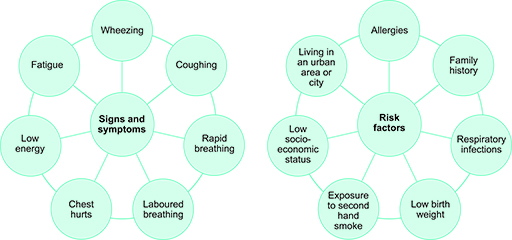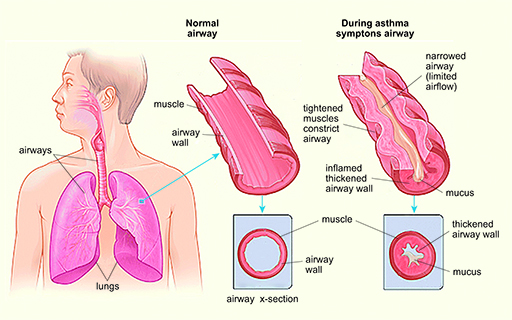1 Childhood asthma
In this section, you will explore the experiences of those who have a diagnosis of childhood asthma and have often been in hospital with severe asthma attacks during childhood. You will explore the common condition found in children and young people, and how it is assessed, diagnosed and managed on a day-to-day and acute basis. You will hear Chloe’s experiences as a young person with asthma and how she copes with asthma and having an asthma attack; a parent of a child with asthma explaining how it felt to be part of the diagnostic process; and when children are hospitalised with acute episodes.
Childhood asthma (pediatric asthma) is the most common serious chronic disease in infants and children; yet is difficult to diagnose.
Explore Figure 1 to learn more about the common signs, symptoms and risk factors of asthma.
Activity 1 Biological development of the respiratory system (children) and pathophysiology of childhood asthma
Watch the following video and on a piece of paper create a labelled diagram that identifies the difference between a normal and asthmatic airway. Then produce a list of ‘triggers’ that might affect asthmatics.

Transcript: Video 1 Asthma pathophysiology / Respiratory system diseases
Discussion
Your diagram might have had the following features shown in Figure 2.
You may have identified the following triggers:
- infections e.g. a cold
- allergens such as pollen, animal fur or dust mites
- cigarette smoke
- pollution
- medicines
- mould
- weather changes, such as cooler weather in the winter
- exercise.
As a person working with or caring for children and young people with asthma, it is important that you are vigilant to signs of deterioration in health and wellbeing and that you know how and when to escalate any concerns. It is often useful to understand how asthma is diagnosed. In the next section you will look at the assessment and diagnosis of asthma.


